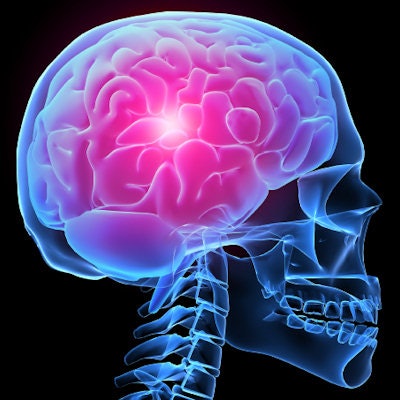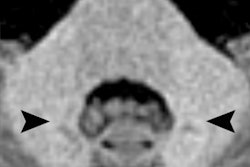
As researchers explore the potential long-term effects of gadolinium-based contrast agents (GBCAs), the direct measurement on MRI scans of T1 and T2 signal intensities in the brain may become a reliable method, according to a study published online October 31 in Radiology.
Researchers from Boston Medical Center found a significant correlation between T1 and T2 values and previous GBCA exposure for the entire brain and in certain regions. The findings also support previous studies on the presence of gadolinium deposits throughout the brain following administration of GBCAs.
"Because it is still unknown whether these gadolinium deposits can have long-term health implications, the development of noninvasive techniques for monitoring gadolinium deposition levels is imperative," wrote lead author Dr. Hirofumi Kuno, PhD, and colleagues. "The direct measurement of T1 and T2 may be a reliable method for evaluation of the global and local administration of gadolinium" (Radiology, October 31, 2016).
Lingering effects
A considerable amount of research over the past three years has focused on the potential long-term effects of GBCAs on patients imaged for a variety of reasons. The interest was sparked most notably by a 2013 study by Kanda et al, which found high signal intensity in the dentate nucleus and globus pallidus on unenhanced T1-weighted MRI scans in 19 patients who had received six or more GBCA injections.
Several other studies followed with similarly concerning results involving minute traces of gadolinium in brain tissue years after administration. Of particular note is that remnants of contrast agents were discovered in patients with normal renal function by way of increased signal intensity in selected regions of the brain on T1-weighted MR images.
Previous studies have also used T1- and T2-weighted signal intensities to investigate leftover evidence of GBCAs years after injection with the help of semiquantitative measures in only certain regions of the brain.
"However, to the best of our knowledge, direct quantitative MR imaging studies of potential T1 reductions related to gadolinium deposition in the entire brain have not been reported in the literature," wrote the authors of the current study.
Kuno and colleagues enrolled 35 subjects who were imaged on a 1.5-tesla MRI scanner (Intera and Achieva, Philips Healthcare) using a fast spin-echo pulse sequence protocol and quadrature head coils between May 2005 and April 2014.
Nine patients (26%) with a median age of 47 years previously received one to eight injections of gadopentetate dimeglumine (Magnevist, Bayer HealthCare) for a variety of clinical indications, including seizure, headache, and metastasis screening for breast cancer. No other GBCAs were used. The other 26 patients (74%) had a median age of 38.5 years and no history of having received a GBCA.
The researchers reviewed T1 and T2 signal intensities of the whole brain's white and gray matter with a dual-clustering algorithm. Their analysis of brain regions zeroed in on the globus pallidus, dentate nucleus, thalamus, and pons.
Signal reflections
An analysis of the entire brain found significantly shorter T1 values in the gray matter of patients who received gadopentetate dimeglumine, compared with patients with no GBCA exposure (p = 0.023). However, there was no significant difference in T1 values in the white matter between the two groups (p = 0.664). Mean T2 values for the whole brain also did not differ significantly between the two patient groups (p = 0.299).
| Global assessment based on GBCA exposure | |||
| No GBCA exposure | GBCA exposure | p-value | |
| T1 values (msec) | |||
| Gray matter | 1006.9 ± 42.6 | 944.7 ± 76.0 | 0.023 |
| White matter | 717.5 ± 70.0 | 702.5 ± 60.5 | 0.664 |
| T2 values (msec) | |||
| Whole brain | 110.4 ± 6.8 | 106.5 ± 8.1 | 0.229 |
There also was a significant correlation between the total accumulated dose of GBCA and T1 values. More specifically, there was a significant difference for gray matter (p < 0.001) and in the globus pallidus (p = 0.002), dentate nucleus (p = 0.046), and thalamus (p = 0.026). There was no such statistical significance in the pons (p = 0.103).
T2 values revealed a significant correlation with the accumulated dose of GBCA for the whole brain (p = 0.004), dentate nucleus (p = 0.023), and thalamus (p = 0.002).
"Our results confirmed previously reported findings that gadolinium deposition is widely distributed throughout the brain and that the gray matter and deep gray nuclei are the most affected," the authors wrote. "Because it is still unknown whether these gadolinium deposits can have long-term health implications, the development of noninvasive techniques for monitoring gadolinium deposition levels is imperative."
They also suggested that measuring T1 and T2 values in the brain could become a "reliable method for evaluation of the global and local administration of gadolinium."
Kuno and colleagues cited several limitations of the study including the relatively small number of patients who received GBCA injections, especially individuals who received more than three. They recommended additional research with a larger patient group to validate the findings.


.fFmgij6Hin.png?auto=compress%2Cformat&fit=crop&h=100&q=70&w=100)





.fFmgij6Hin.png?auto=compress%2Cformat&fit=crop&h=167&q=70&w=250)











